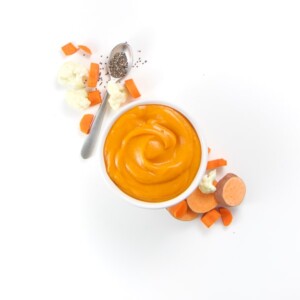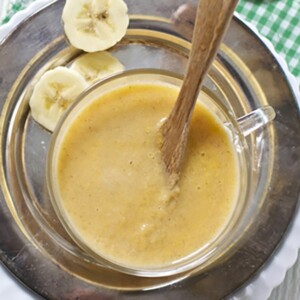Learn how to serve chia seeds for your baby, for either baby-led weaning as a puree. Chia seeds are a wonderful source of omega-3 fatty acids, as well as B vitamins, iron, calcium and zinc. They’re a nutritious addition to foods for babies 6 months and up.
Medically reviewed and cowritten by Jamie Johnson, Registered Dietitian Nutritionist (RDN), and Lauren Braaten, Pediatric Occupational Therapist (OT).
Chia Seed Baby Food
I know, I know, chia seeds are most likely not one of the first foods people think of when they start introducing foods to your baby.
Chia seeds belong to a flowering plant in the mint family, and while not typically eaten by themselves, they are a powerful little seed that many people add to different foods for nutritional value.
In fact, chia seeds are a great way to include more omega-3s, protein, B vitamins, iron, zinc, and calcium to your baby’s diet. In addition, chia seeds are rich in soluble fiber, helping with digestion and relieving constipation.
In this guide, we’ll cover all the information you need in order to safely serve chia seeds to your baby. You’ll learn about the nutritional benefits, FAQs, helpful tools, and expert feeding tips.
First time making homemade baby food? Then, I would suggest that you start by reading my very in-depth Complete Guide to Baby-Led Weaning – which covers what exactly is baby-led weaning, to every parent’s concern of baby-led weaning and choking, this guide goes over it all. I will also share how to know when baby is ready for BLW, the top 10 best first foods, a helpful sample blw feeding schedule, helpful tools to have on hand, and much much more!
You can also check out my best-selling cookbook for even more information and recipes!

Reasons to Love Chia Seeds for Baby
- Great for baby-led weaning – 6+ months
- Also great for the finger food stage – 9+ months
- Full of essential nutrients for baby
- Different ways for baby to eat – spoon-fed or self-feed
- Easy to prepare
- Introduces baby to new food textures
Health Benefits of Chia Seeds
Chia seeds might be tiny, but they are mighty when it comes to nutritional benefits!
- They are an excellent source of fiber for healthy digestion.
- They are a good source of Omega 3 fatty acids and iron, both important for babies’ development.
- They are a good source of calcium for healthy bones.
- They are high in other minerals like phosphorus, magnesium, copper and selenium.

Types of Chia Seeds
There are two different kinds of chia seeds, black and white. Nutritionally speaking, there is not much difference between the two. Avoid brown chia seeds if you happen to find them, as they won’t have the same nutritional value.
- Black chia seeds: typically more common than white chia seeds; they have a slightly higher protein content
- White chia seeds: have slightly more omega-3s compared to black chia seeds
How to Choose and Store Chia Seeds
Ideally, look for chia seeds that are organically grown. Consider how often you’ll likely be using chia seeds, as a small amount will often last quite a while. Chia seeds should have a mild, nutty aroma. If the chia seeds smell rancid or clump together in the package, you should throw them away.
Chia seeds have a long shelf life. They can be stored in an airtight, dark colored container in the fridge or freezer for up to 4 years. Even when stored in a sealed container in the pantry away from heat sources, they’ll last at least 2 years.

How to Prepare Chia Seeds for Baby
Chia seeds are a versatile food, with a mild taste. Here are a few ideas on how to enjoy them with your baby.
- Stirred into yogurt, pureed fruits or veggies or oatmeal
- Hydrating or “gelling” chia seeds can even be used as an egg substitute in baked goods, since they can absorb more than 10 times their weight in liquid
- For toddlers closer to 12-18 months, you can start to add chia seeds to drinks like smoothies or drinks
Spices to Add
You can serve chia seeds as-is or pair them with other flavors. Some spices that go well with chia seeds include cinnamon, nutmeg, pumpkin spice blend, vanilla, and mint.
Frequently Asked Questions
Yes, chia seeds can be one of your baby’s first foods, as soon as they are ready to start solids. This is usually around 6 months of age.
No, chia seeds are not a common allergen. As you would with introducing any new food, start by offering a small amount and monitor your baby as they eat for any adverse reactions.
Yes, they can be if not served properly. Chia seeds can expand to 10x their size upon contact with moisture (including saliva) and then stick together in clumps, which increases choking risks.
To minimize this risk, soak chia seeds for 30 minutes before serving and break up any clumps of chia seeds with a fork. Sprinkling a small amount of dry chia seeds on top of foods is okay, but avoid serving spoonfuls of dry seeds.
Chia seeds are high in soluble fiber, which aids in digestion and can relieve constipation. However, serve in moderation, as overconsuming chia seeds can cause baby to feel too full and may cause mild discomfort.






Helpful Tools
Here are some products that help you make and serve chia seeds to your baby even easier! To find even more products that I love, make sure to check out my online shop.
Chia Seed Puree (Chia Seed Pudding)



One of the easiest ways to serve chia seeds to your baby is to mix them into a chia pudding.
- In a small air-tight container, blend together a mashed banana, cinnamon and chia seeds.
- Add in the chia seeds and cover with a lid.
- Place the container in the fridge and refrigerate for at least 30 minutes, but preferably overnight.
Puree Tip: for a traditional smooth puree, you can add all ingredients into a blender and blend for 30-60 seconds or until just smooth (some lumps are okay) before pouring the mixture into an air-tight container and letting sit overnight in the fridge.

Chia Seeds for Baby-Led Weaning
Chia seeds are a great food for your baby to self-feed, whether for baby-led weaning, which happens around 6 months of age, or during the finger foods stage at 9 months.
Pre-soaked, stirred into purees or chia seed pudding (6 -18 months): Serve pre-soaked chia seeds to your baby by stirring them into yogurt, fruit or vegetable purees, warm cereals, or making a chia seed pudding (let all sit for at least 30 minutes before serving). Baby can self-feed by scooping the puree with their hands or offer them a pre-loaded utensil. You can also sprinkle a small amount of dry seeds onto these types of foods, but avoid serving dry spoonfuls of chia seeds.
Stirred into purees, puddings or blended into smoothies and drinks (18+ months): You can continue offering pre-soaked chia seeds added to purees at this age. You can also serve chia seeds mixed into smoothies or a drink like a chia fresca.
Storage Instructions
Chia Seed Puree
Refrigerator
You can store it in an airtight container in the fridge for up to 4 days.
Freezer
This puree can be frozen for up to 4 months.
- Spoon puree into a freezer storage container – do not overfill.
- Place the lid on the storage container or cover it with a piece of saran wrap and label it with the date and recipe name.
- Place the tray into the freezer and let freeze completely – preferably overnight.
- Pop out the baby food cubes and place them in a zip-lock baggie or stasher bag – don’t forget to re-label the baggie or stasher bag for future reference.
Baby-Led Weaning – edit
You can store chia pudding in an air-tight container in the fridge for up to 4 days.
More Favorite Recipes



Feeding Tips
- To minimize choking risks, soak chia seeds for 30 minutes before serving and break up any clumps of chia seeds with a fork.
- Sprinkling a small amount of dry chia seeds on top of foods is okay but avoid serving spoonfuls of dry seeds.
- Offering a pre-loaded utensil or a baby self-feeding utensil like the NumNum Gootensil can be helpful when your baby is first learning to eat.
- Chia seeds are also great to roll slippery foods in, like avocado or mango slices, to help baby grasp them and make them easier to hold.
- You can also add chia seeds to pancakes, breads, muffins, etc. to boost their nutritional value.
Smooth Puree: for a traditional smooth puree, you can add all ingredients into a blender and blend for 30-60 seconds or until just smooth (some lumps are okay) before pouring the mixture into an air-tight container and letting sit overnight in the fridge.
Storage: leave the chia seed pudding in the air-tight container for up to 4 days in the fridge.


